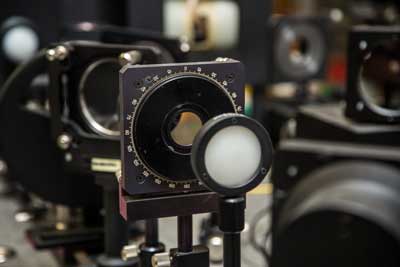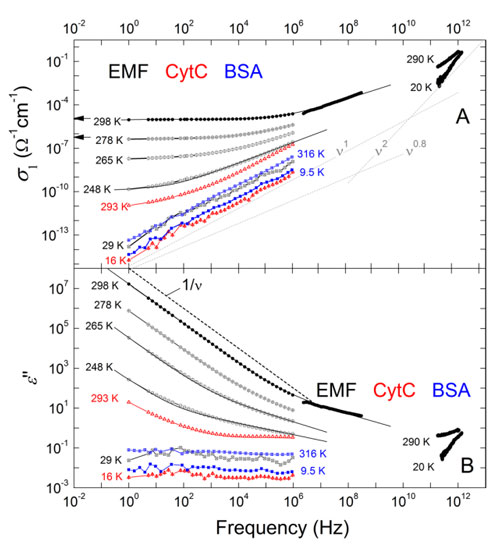Solid-state physics offers insights into dielectric properties of biomaterials
| A
team of Russian, Czech and German researchers gained a new perspective
on the properties of three materials of biological origin. Besides two
reference materials with well-studied properties — serum albumin and
cytochrome C — the researchers looked at the extracellular matrix of the
Shewanella oneidensis MR-1 bacterium, which is used in biofuel cells.
The team measured the materials’ dynamic conductivity and dielectric
permittivity in a wide range of frequencies and temperatures. To
interpret their findings, the researchers used theoretical approaches
and concepts from condensed matter physics. 一個由俄羅斯,捷克和德國三國組成的研究小組,對三種生物來源材料的特性進行了全新的觀察。 除了具有良好研究性質的兩種參考材料 - 血清白蛋白和細胞色素C,研究人員還研究了用于生物燃料細胞的Shewanella oneidensis MR-1細菌的細胞外基質。 該團隊在廣泛的頻率和溫度范圍內測量了材料的動態電導率和介電常數。 為了解釋他們的發現,研究人員使用了凝聚態物理的理論方法和概念。 | ||
| The paper detailing the study was published in the journal Scientific Reports ("Observation of dielectric universalities in albumin, cytochrome C and Shewanella oneidensis MR-1 extracellular matrix"). | ||
 | ||
| The research was conducted using a terahertz spectrometer. (Image: Evgeniy Pelevin, MIPT) | ||
| “So far, the formalism of condensed matter physics has only found limited use in classical biochemistry and biophysics. As a result, certain interesting effects evade our attention,” says Konstantin Motovilov, senior research scientist at the Laboratory of Terahertz Spectroscopy. “When we do make use of this language, we acquire new ways of modeling observed phenomena and describing biological structures. In our paper, we characterize the behavior of proteins, considered as classical amorphous semiconductors, with the help of the formalism of condensed matter physics.” | ||
| Before discussing the study, here is a quick example of how solid-state physics explains the electrical properties of different materials. | ||
| There are in fact multiple mechanisms of electrical conductivity. For each, there is a corresponding theory that describes the properties of certain materials. For example, the conductivity in metals is adequately explained by the Drude theory. In the theory, there is no interaction between the conduction electrons, which are assumed to only occasionally collide with crystal lattice, impurities, and defects. Electrical conductivity is the inverse of electrical resistivity. | ||
| Conductivity indicates how easy it is for an electric current to pass through a given material. Within the Drude model, this property does not depend strongly on frequency up to the frequency of the collisions between charge carriers and lattice or impurities. However, there is a large group of conductive materials that do not fit this description. Yet their behavior in an external electromagnetic field is quite interesting. Among them are glasses, ionic conductors, and amorphous semiconductors. | ||
| To qualitatively describe the electrical properties of such materials, another theory was proposed about 40 years ago by Andrzej Karol Jonscher, an English physicist (Nature, "The ‘universal’ dielectric response"). | ||
| According to his theory, charge carriers — electrons, for example — can adequately be considered as free at room temperature, provided the alternating current frequency does not exceed several megahertz. Under these conditions, the Drude model is applicable and conductivity is nearly constant, i.e., it does not depend on the frequency of the external field. If, however, the frequency is higher, this description is no longer valid and there is an increase in conductivity proportional to a certain power — which is close to 0.8 — of frequency. The same effect is observed for materials that are gradually cooled, even if the frequency is kept constant. | ||
| Interestingly, different materials exhibit quite similar behavior in that regard. Moreover, if you restate the dependences — say, talk about the ratio between direct current (static) conductivity and alternating current conductivity, as opposed to conductivity as such — the relations for all materials turn out to be identical, revealing the so-called Universal Dielectric Response (UDR). This curious phenomenon was thoroughly investigated in a study (Journal of Applied Physics, "The random free-energy barrier model for ac conduction in disordered solids") that examined the conduction in glasses and other amorphous materials, offering new insights into their structure and properties. | ||
| The authors of the paper showed that Jonscher’s law for conductivity applies to three organic materials. Among them, two are well-known reference proteins: bovine serum albumin and bovine heart cytochrome C. Their structural, physical, and chemical properties have been investigated in detail, so the researchers used them as reference materials. | ||
| In addition, they examined the extracellular matrix and filaments (EMF) of the Shewanella oneidensis MR-1 bacterium, which can produce electricity in biological fuel cells. S. oneidensis has been used in many studies with a focus on alternative energy sources, so its electrical properties are of interest to both researchers and engineers. In 2010, a team of researchers based in the United States and Canada showed that the bacterium’s extracellular appendages behave a lot like p-type semiconductors (PNAS, "Electrical transport along bacterial nanowires from Shewanella oneidensis MR-1"). The electrical properties of S. oneidensis MR-1 have nevertheless not been studied in detail. The recently published paper is an attempt to remedy that. | ||
| The authors measured the conductivity of the materials, as well as the energy losses in a frequency range from 1 hertz to 1.5 terahertz, or trillion hertz, for temperatures from -260 to 40 degrees Celsius. (Strictly speaking, the energy losses are given by the imaginary part of the complex dielectric permittivity.) Next, the researchers measured the direct current conductivity of EMF for temperatures from zero to 40 C, as well as the temperature dependence of their heat capacity. For each of the three materials, water content and ion concentration were also determined. | ||
| To do this, the researchers pressed the substances into pellets using a 1-centimeter mold. They then applied electrodes to the faces of the pellets to pass alternating current through them in order to measure the electrical conductivity and dielectric permittivity of the materials in the 1-300 million hertz range. For higher frequencies, this approach does not work, so for the 30-1,500 gigahertz, or billion hertz, range, the team obtained the spectra of complex dielectric permittivity using quasioptical terahertz spectroscopy. No measurements were made in the intermediate frequency range. | ||
| It turned out that at room temperature, EMF conductivity is nearly constant, and when the frequency is increased above several million hertz, or several megahertz, the conductivity is proportional to a certain power — which is close to 1 — of the frequency. Cytochrome C did not exhibit such behavior unless the frequency was low and the temperature high. In the case of albumin, it was not observed at all. This suggests that different conductivity mechanisms are at play in these materials. It is likely that EMF has nearly free charges at room temperature — just like in the Drude model — whereas albumin does not have them and cytochrome C is a mixed bag. | ||
 | ||
| This graph illustrates the frequency dependences of conductivity (top) and dielectric permittivity — or rather, its imaginary part corresponding to energy losses (bottom) — for various temperatures. The data for albumin, cytochrome, and EMF are plotted in blue, red, and black, respectively. The graph shows that the conductivity of EMF is almost constant for low frequencies and near room temperature, whereas an increase in frequency or a decrease in temperature causes conductivity to grow linearly with the frequency. For albumin and cytochrome, conductivity exhibits a linear growth throughout the frequency and temperature range, whereas the energy losses are constant. (Image: K.A. Motovilov et al. / Scientific Reports 7, 15731 (2017)) | ||
| The dependence observed by the researchers can be explained in terms of the individual properties of the materials. Both cytochrome C and albumin are regular proteins. Although these materials do have some free charges, these are not nearly as many as it would be necessary to justify the Drude model. Comparing the conductivity in EMF to that in metals (conductors) is more realistic, as free charges are more easily generated in these molecules. However, a comparison even more valid would be that with a solution of table salt, which has a high concentration of free ions. | ||
| Naturally, a complete description is more complex and would require us to take the water content of materials and other factors into account. For instance, because EMF contains significant amounts of loosely bound water, its conductivity grows quadratically at temperatures of about -250 C and frequencies on the order of 100 billion hertz (sub-terahertz terahertz range). Temperatures that low cause the bulk water in the material to freeze, and high frequencies mean that the dielectric properties resulting from water dipole dynamics become non-negligible. The other materials, too, exhibit deviations from Jonscher’s predictions, but they are not as dramatic. | ||
| The
authors have thus clearly shown the powerful methodology and
instrumentation of condensed matter physics to be effective for
fundamental research into the electrodynamics of biological objects. The
next step could involve the application to biomaterials research of the
wide range of other theories and models that have been effectively used
by the physics community for many decades. | 當然,完整的描述更加復雜,需要我們考慮材料的含水量和其他因素。例如,由于EMF包含大量松散結合的水,其電導率在約-250℃的溫度和約1000億赫茲(亞太赫茲太赫茲范圍)的頻率下以二次方增長。低的溫度導致材料中的大量水分凍結,而高頻率意味著由水偶極子動力學引起的介電性能變得不可忽略。其他材料也顯示出與Jonscher的預言不一致,但并不是那么戲劇化。 | 因此,論文作者清楚地展示了凝聚態物理學的有效方法和工具,對于生物物體的電動力學的基礎研究是有效的。下一步可能涉及生物材料研究的其他理論和模型,物理界已有效使用了數十年的廣泛的研究。 |